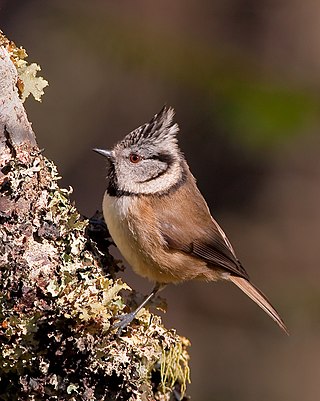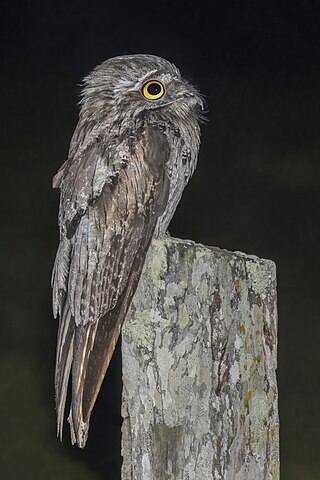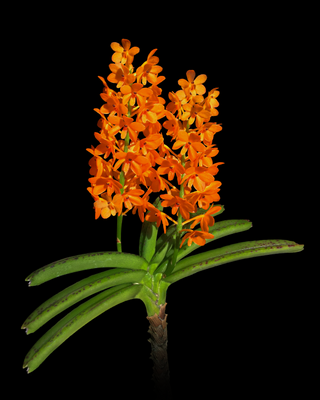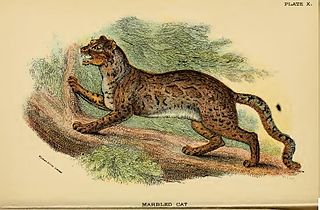
Galagos, also known as bush babies, or nagapies, are small nocturnal primates native to continental, sub-Sahara Africa, and make up the family Galagidae. They are considered a sister group of the Lorisidae.
Family is one of the eight major hierarchical taxonomic ranks in Linnaean taxonomy. It is classified between order and genus. A family may be divided into subfamilies, which are intermediate ranks between the ranks of family and genus. The official family names are Latin in origin; however, popular names are often used: for example, walnut trees and hickory trees belong to the family Juglandaceae, but that family is commonly referred to as the "walnut family".

Columbidae is a bird family consisting of doves and pigeons. It is the only family in the order Columbiformes. These are stout-bodied birds with short necks and short slender bills that in some species feature fleshy ceres. They primarily feed on plants, and can be taxonomically divided amongst granivores, that feed mostly on the ground on seeds, and frugivores, that feed mostly on fruits, from branches. The family occurs worldwide, often in close proximity with humans, but the greatest variety is in the Indomalayan and Australasian realms.

The treecreepers are a family, Certhiidae, of small passerine birds, widespread in wooded regions of the Northern Hemisphere and sub-Saharan Africa. The family contains eleven species in two genera, Certhia and Salpornis. Their plumage is dull-coloured, and as their name implies, they climb over the surface of trees in search of food.

The tits, chickadees, and titmice constitute the Paridae, a large family of small passerine birds which occur mainly in the Northern Hemisphere and Africa. Most were formerly classified in the genus Parus.

Potoos are a group of birds related to the nightjars and frogmouths. They are sometimes called poor-me-ones, after their haunting calls. The family Nyctibiidae was formerly included with the nightjars in the order Caprimulgiformes but is now placed in a separate order, Nyctibiiformes. There are seven species in two genera in tropical Central and South America. Fossil evidence indicates that they also inhabited Europe during the Paleogene.

The Geoemydidae are one of the largest and most diverse families in the order Testudines (turtles), with about 70 species. The family includes the Eurasian pond and river turtles and Neotropical wood turtles. Members of this family are commonly called Leaf turtle.

A raceme or racemoid is an unbranched, indeterminate type of inflorescence bearing flowers having short floral stalks along the shoots that bear the flowers. The oldest flowers grow close to the base and new flowers are produced as the shoot grows in height, with no predetermined growth limit. Examples of racemes occur on mustard and radish plants.

Hazels are plants of the genus Corylus of deciduous trees and large shrubs native to the temperate Northern Hemisphere. The genus is usually placed in the birch family Betulaceae, though some botanists split the hazels into a separate family Corylaceae. The fruit of the hazel is the hazelnut.

Pardofelis is a genus of the cat family Felidae. This genus is defined as including one species native to Southeast Asia: the marbled cat. Two other species, formerly classified to this genus, now belong to the genus Catopuma.
The Syndiniales are an order of early branching dinoflagellates, found as parasites of crustaceans, fish, algae, cnidarians, and protists. The trophic form is often multinucleate, and ultimately divides to form motile spores, which have two flagella in typical dinoflagellate arrangement. They lack a theca and chloroplasts, and unlike all other orders, the nucleus is never a dinokaryon. A well-studied example is Amoebophrya, which is a parasite of other dinoflagellates and may play a part in ending red tides. Several MALV groups have been assigned to Syndiniales; recent studies, however, show paraphyly of MALVs suggesting that only those groups that branch as sister to dinokaryotes belong to Syndiniales.
In phylogenetics, basal is the direction of the base of a rooted phylogenetic tree or cladogram. The term may be more strictly applied only to nodes adjacent to the root, or more loosely applied to nodes regarded as being close to the root. Note that extant taxa that lie on branches connecting directly to the root are not more closely related to the root than any other extant taxa.

Blastocladiomycota is one of the currently recognized phyla within the kingdom Fungi. Blastocladiomycota was originally the order Blastocladiales within the phylum Chytridiomycota until molecular and zoospore ultrastructural characters were used to demonstrate it was not monophyletic with Chytridiomycota. The order was first erected by Petersen for a single genus, Blastocladia, which was originally considered a member of the oomycetes. Accordingly, members of Blastocladiomycota are often referred to colloquially as "chytrids." However, some feel "chytrid" should refer only to members of Chytridiomycota. Thus, members of Blastocladiomyota are commonly called "blastoclads" by mycologists. Alternatively, members of Blastocladiomycota, Chytridiomycota, and Neocallimastigomycota lumped together as the zoosporic true fungi. Blastocladiomycota contains 5 families and approximately 12 genera. This early diverging branch of kingdom Fungi is the first to exhibit alternation of generations. As well, two (once) popular model organisms—Allomyces macrogynus and Blastocladiella emersonii—belong to this phylum.

In biology, taxonomic rank is the relative level of a group of organisms in an ancestral or hereditary hierarchy. A common system of biological classification (taxonomy) consists of species, genus, family, order, class, phylum, kingdom, and domain. While older approaches to taxonomic classification were phenomenological, forming groups on the basis of similarities in appearance, organic structure and behaviour, methods based on genetic analysis have opened the road to cladistics.

Corethrellidae are a family of biting midges, small flying insects belonging to the order Diptera, females of which feed on the blood of frogs. The members of the family are sometimes known as frog-biting midges. The family currently consists of just one genus, totalling 115 extant and 10 fossil species worldwide. Most extant species are found in the lower latitudes, usually associated around the tropics.

The clavarioid fungi are a group of fungi in the Basidiomycota typically having erect, simple or branched basidiocarps that are formed on the ground, on decaying vegetation, or on dead wood. They are colloquially called club fungi and coral fungi.
Schizotheca may refer to:

Schizoretepora is a genus of bryozoans belonging to the family Phidoloporidae.
Phidolopora is a genus of bryozoans belonging to the family Phidoloporidae.














